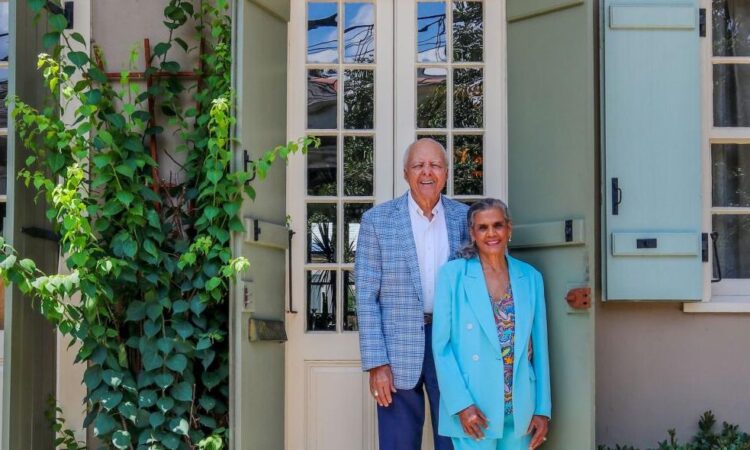Treme couple occupies a ‘new’ Creole cottage, but their real passion is for historic restoration | Entertainment/Life

The Creole cottage on Henriette Delille Street in Treme looks like it’s been there for as long as the neighborhood has been around.
Ask Adolph and Naydja Bynum how old it is, though, and the answer will surprise you: just 25 years.
“I’ve had a lot of architects tell me ‘That’s a nice renovation,’” Adolph Bynum Sr. said with a smile.
While the home was built from the ground up a quarter-century ago, he has spent nearly twice as long as that restoring homes in Treme that are significantly older.
Since the late 1970s, he’s redone about 16 properties. Some he’s kept and rented. Others he’s sold. Another — a camelback double on Marais and Barracks streets — is being worked on right now.
“We call each of our houses our child,” he said, referring to the love he and Naydja Bynum have for the homes they’ve worked on.
It was never his or his wife’s intention, though, to save so many properties in Treme or become boosters for the historic neighborhood, which was recognized by the city in 1812.

The home of Adolph and Naydja Bynum
‘My own oasis’
The only reason Adolph Bynum wound up there was that parking in the French Quarter, where he wanted to buy a place, was difficult. He found that it was easier in the blocks across North Rampart Street.
“That’s why I never got to the Quarter,” he said.
It was regular trips to the French Quarter with his mother, Inez Fields Bynum, however, that unknowingly laid a foundation for his interest in preservation.
His mother would point out elements of historic buildings during those visits to the city’s oldest neighborhood. While young Adolph grew to appreciate the city in which he grew up, he didn’t set out to be a preservationist.
He attended Xavier University and became a pharmacist like his dad, Horace Bynum Sr., opening his own drugstore in the Desire area in 1961 with the help of his father. (It remained in operation until Hurricane Katrina in 2005.)

The Bynums tore down this mid-century ranch home on Henriette Delille to build their Creole cottage about 25 years ago. A similar Creole cottage had been torn down to build the ranch home.
He bought a house in Pontchartrain Park. When he was ready to move, with the Quarter ruled out,
Bynum set his sights on Treme.
“All my friends thought I was nuts,” he said, noting that at the time, the area was known more for blight and crime than its history. But he had a gut feeling. “I told them, ‘Someday the value of this area will be sky high.’”
He bought a yellow cottage in the 1200 block of what was then St. Claude Avenue, now Henrielle Delille, and began to restore it.
“I’ll make my own French Quarter,” he told himself.
Soon, he added additional buildings on the block and wound up joining the yards, creating one large courtyard, reminiscent of those in the Quarter.
“I made my own oasis,” he said.

The renovated ‘She Shed’ was once home to Alphonse Picou, an early jazz pioneer. These days the Bynums use it as an event space and rental property.
‘You’re a preservationist’
His renovation work caught the eye of Patty Gay, the Preservation Resource Center’s longtime director, and Muffin Ballart, a longtime PRC supporter and former board president, who asked him to give a presentation about buying historic properties.
“You’re a preservationist,” he remembered Gay telling him after that talk.
“I am?” he asked.
“You sure are,” she said.
He became more involved with the PRC, eventually serving on its board of directors and various committees in the early and mid-1990s.
It was around that time he met the woman who would become his wife.
Naydja Bynum was born in New Orleans and also developed a love of the city’s historic architecture as a child, thanks to her father, John Domingue Sr., and his career as a carpenter.
She remembers doing work with him and her brothers at times, sanding floors and helping with other aspects of a job.

The steeple of St. Augustine Church in Treme, one of the recipients of grants from the community fall festival that the Bynums founded.
She made her career in the medical field, serving as a nursing educator and administrator at hospitals in New Orleans, Baltimore and Los Angeles.
Her time on the East and West coasts was formative. She realized the city’s older housing stock was more than just charming, Bynum said. It offered more value for less money.
“Because I left, I got to appreciate New Orleans more,” she added.
She met Adolph Bynum in the mid-’90s, and the two quickly bonded over their medical backgrounds and passion for preservation.
“Our dates were driving around neighborhoods looking for ‘for sale’ signs,” Adolph Bynum said.
Naydja Bynum would follow Adolph Bynum onto the PRC’s board, eventually serving as president, all while continuing to buy and restore properties across the city and working on a doctorate degree in nursing at LSU Medical Center.
“I’m a nurse. I help people get well,” she said. “Now I get homes well.”
Aside from their work rehabbing homes, the Bynums have also become boosters for Treme.

The Backstreet Cultural Museum is housed in a building owned and renovated by the Bynums.
They’ve served on the board of the Historic Faubourg Treme Association and founded the Treme Fall Festival, which recently celebrated its 10th anniversary. Festival proceeds are reinvested in the neighborhood through eight to 10 grants to cultural and educational organizations.
For example, during the last decade, the festival has granted more than $100,000 to St. Augustine Church, which remains closed and in need of repairs after Hurricane Ida in August 2021.
Grants also have gone to the New Orleans African American Museum, the Backstreet Cultural Museum, St. Anna’s Episcopal Church’s musical programs, Treme’s Petit Jazz Museum and others. Various second-line groups, the Baby Dolls and Mardi Gras Indian groups have also been recipients.
“We got a lot of history, a lot of culture here,” Naydja Bynum said.
The strongest way the Bynums have helped the neighborhood, however, is by simply being there.
No place like home

The dining room includes features such as a brick-between-post wall to honor the neighborhood’s historic building practices.
Their presence was solidified when they built their home just before Katrina.
A Creole cottage that once stood on their property was bulldozed at some point, likely in the 1950s. A one-story slab house — perfect for a suburban setting — was put up.
But it didn’t fit in with Treme at all. The Bynums eventually bought it and tore it down.
The city approved their plans to build a new Creole cottage, one inspired by another in the same block that Adolph Bynum had renovated years earlier.
Outside, their home is covered in tan stucco, with green shutters custom-made at a mill shop in Folsom.
The floors inside are Brazilian cherry, while the cabinets are made of cypress.
“Everything was tailor-made,” Adolph Bynum said.
A wall in the dining room is done in a brick-between-post style, an homage to the neighborhood’s historic building practices. “We did one wall like that to make it look like a Creole cottage (inside and out),” Naydja Bynum said.
Another project the Bynums are proud of is the restoration of what they call the “She Shed” at Ursulines Avenue and North Robertson Street.

A gracefully curving staircase leads to the second floor of the Bynums’ home.
The two-story building, now painted a bright shade of lavender with gold trim, was boarded up for years and left to fall apart after being used as a barroom.
In a past life, it was home to Alphonse Picou, an early jazz pioneer who lived there with his daughter. These days, the Bynums use it as an event space and rental property.
A changing neighborhood
The historically Black neighborhood — which the City Planning Commission defines as being bounded by North Rampart Street, Esplanade Avenue, North Broad Street and St. Louis Street — has seen a lot of change since Katrina.

The art-filled living room with a view through to the dining area
According to U.S. census data, the population dropped from 8,853 in 2000 to 5,849 during a survey conducted between 2019 and 2023.
At the same time, the Black population has gone from 93% to 58%, while the White population has increased from 5% to 28%.
Other figures show an increase in home ownership in the neighborhood, an increase in salaries and an increase in education levels.
Regardless of what any statistics say, Adolph Bynum said he hopes people will see the value in Treme and invest in it.
“It’s the center of the city. I can get anywhere I need to go. I know my neighbors, and we look out for each other,” he said. “There’s a lot of good.”
This story was reported by The Preservation Resource Center, a nonprofit whose mission is to preserve New Orleans’ historic architecture, neighborhoods and cultural identity. For information, visit prcno.org.






